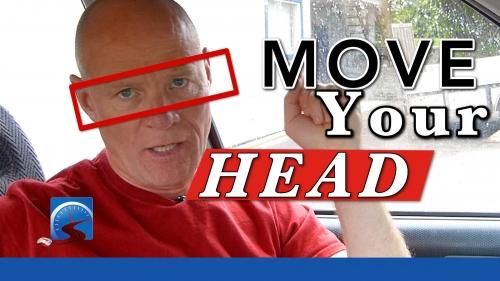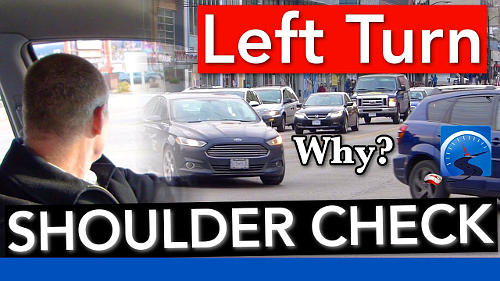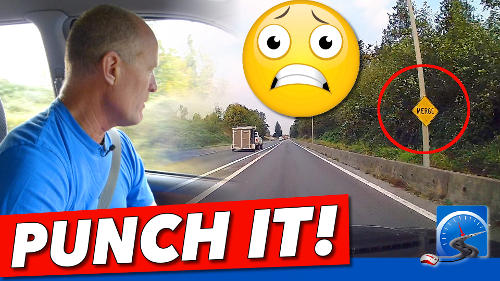10 Defensive Driving tips & techniques to be a smarter driver.
10 Ways to NOT Crash | Techniques for Post-Licence Driving
Overview1 Observation Always look twice or more before going 2 Speeding Keep up with the traffic flow to be predictable 3 Communication Better signalling techniques will reduce your chances of being in a crash. 4 The Right Vehicle Get a vehicle that you are comfortable in and like to drive. 5 Left Turns Don't get pressured by other drivers to go...only go when YOU'RE sure! 6 Following Distance It's faster to steer out of an emergency situation than to brake, but you need space in which to drive - CREATE space. 7 Cruise Control On highways and long stretches of straight road, cruise control reduces distracted driving. 8 Shoulder (Head) Checking Any time you move the vehicle sideways, look twice before moving. Never, ever lose this driving skill. 9 Distracted & Impaired Driving It's going to happen. If you develop the habit of a creaing space around your vehicle you're probably going to be okay. 10 Emotional Control Know that other drivers are going to make mistakes. That way, your expectations will line up with reality when it happens. |
Introduction
Talking today about safe and defensive driving.
Had a comment from Claudees a couple of weeks ago.
He wanted to know about some safe and defensive driving practices that he could put in place after he got his license.
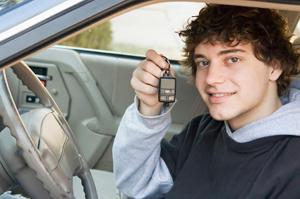
He had been successful on his license and wanted to know what he could do to stay safe on the roadway.
Unfortunately many people believe that once they get their license that provides the benchmark for that which will keep them safe during their driving career.
Unfortunately nothing could be farther from the truth.
The top three reasons for crashing according to traffic safety experts is:
1) speeding;
2) following too close;
3) failing to yield.
The last one I especially like— failing be yield.
As I tell many students when they make an incorrect decision in a particular traffic situation:
"you can be right, or you can be dead right right!"
#1—Observation
Today we're talking about tips to keep you safe after you get your driver's license.
Observe.
Most of the information that we use for driving is collected through our eyes - eighty to ninety percent of the information.
So look, look, look!
When you pull out anywhere in traffic, look twice - always look twice before you go.
It's kind of like carpentry: measure twice, cut once.
Same thing in your car - look twice before you go.
If you are uncertain at all, creep out until you can see.
For example, if you're at an intersection and it's blocked by trees or hedges or what not, creep out until you can see and then once you see and determine that the way is clear then go.
Same thing in parking lots when you're backing out of parking spaces.
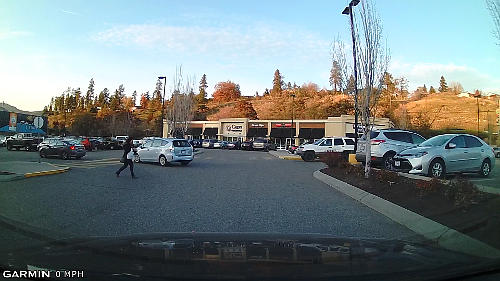
Go slowly if you can't see.
As well, the slower you go the sharper the vehicle turns so often times that allow you to navigate safely in parking lots.
But the other thing is that many people in parking lots - just on that note - get into trouble and have backing crashes because they start moving backwards before they look.
So make sure you look first before you back up.
Especially in grocery store parking lots.
Lots of kids running around and what not and you know...sometimes they get away from parents.
So look twice and then move.
So observation.
#2—Speeding
Speeding, which is one of the number one reasons for crashes.
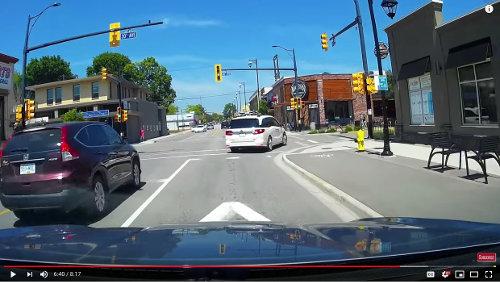
There are many definitions of speeding:
1) driving faster than the traffic flow;
2) driving faster than the posted speed limit;
3) driving faster than me;
4) driving faster than the conditions of the road will allow.
So there's lots of definitions of speeding.
For the purposes of this and after you get your driver's license I would strongly encourage you not to drive faster than the traffic flow.]
Whatever that traffic flow is, stay with the traffic flow.
If you're not comfortable with the traffic flow and you insist on driving the speed limit - stay to the right.
Stay in the right lane.
That way you're not going to impede other traffic that's trying to pass on a multi-lane highways.
As well, we've all seen the signs: stay right unless passing, or or slower traffic stay right.
So if you're driving slower than the traffic flow, stay to the right because one of the things you want to try and do is remain predictable on the roadway.
And one of the ways that you can remain predictable is by staying with the traffic flow.
 #3—Communication
#3—Communication
Communicating with other road users: signalling is one of the most important things.
And if you're not sure, make sure you use your mirrors and your signal and then look and move - ok.
It's important that you give other road users an opportunity to react to your signal.
As I say too many a student, signals are requests that you wish to move over, not that you are moving over!
How many drivers have we seen flip the signal on, and they're moving even before the signal comes on?
So make sure you signal — at least two or three flashes before you start moving over.
That way it gives other traffic time to react.
Because driving is a social experience: it's not just you out there against the masses.
It's an interaction between people driving cars, even though it just seems like an inanimate object beside you there on the roadway.
It's actually another person in that vehicle.
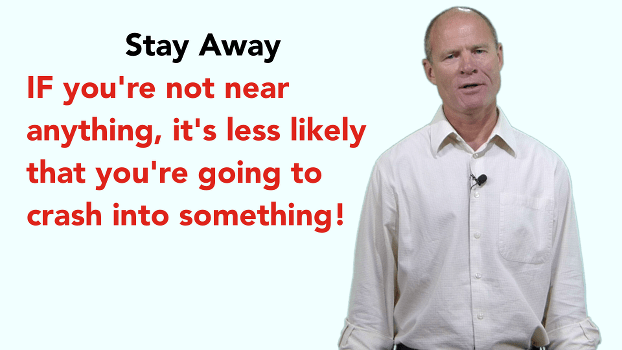 And if you request to move over—a lot of drivers upgrading to a commercial license are surprised somewhat by this— Now we say to them, "put your signal on" and actually ask the person to move.
And if you request to move over—a lot of drivers upgrading to a commercial license are surprised somewhat by this— Now we say to them, "put your signal on" and actually ask the person to move.
Oftentimes the person does move.
So make sure you communicate effectively.
#3a—Position of Vehicle on Road
And one of the most important ways that we communicate on the roadway is the position of our vehicle on the road.
If the vehicle is in the left-hand turning lane, there's a pretty good chance that that vehicle is going to turn left.
So you can predict traffic patterns by figuring out and taking note of where the vehicles are on the roadway.

As well with communicating with other road users hand gestures—appropriate hand gestures—with other road users and eye contact.
If you've got pedestrians and whatnot, make sure you get eye contact with them.
And don't assume that pedestrians will see you, especially at night.
Because sometimes they don't see you or you—vice versa—you don't see them.
So make sure you're on the lookout - make sure you make allowances between those different kinds of road users.
#4—Vehicle Comfort
I know that for many of us what we get in terms of a vehicle we don't really have a lot of choice, but if you've got a bit of choice and you can make some decisions about the kinds of vehicles that you are going to drive pick something that's comfortable for you.
A few years ago I road tested an FJ cruiser.
It's a Toyota vehicle - it's an SUV (Sport Utility Vehicle).
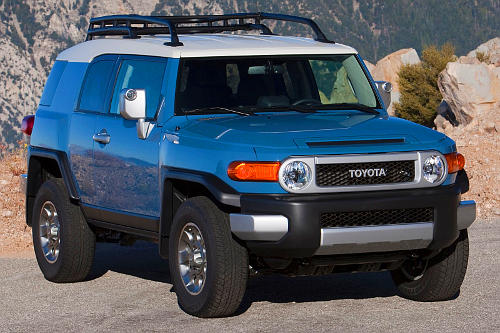
It was very closed in and it was difficult to see.
It had all kinds of blind spots and whatnot.
So when you pick a vehicle, pick something that is comfortable for you to drive.
You don't want to be driving a big Ford F-350 if you're five feet tall and you're trying to climb in and out of this thing and you can't see over the steering wheel and you got to get this thing in and around parking lots, or those types of things.
It's not practical - so buy something that's practical.
If you have a vehicle that you're comfortable driving, you like driving it, it's fun to drive, and it doesn't have enormous numbers of blind spots, it's going to be safer for you.
As well, keep your vehicle well maintained, keep the inside of it relatively clean.
If it's clean, it's going to feel safer.
So the vehicle - make sure you fit the vehicle that you're going to drive.
It just makes life a whole lot simpler.
You're trying to get it around the parking lots.
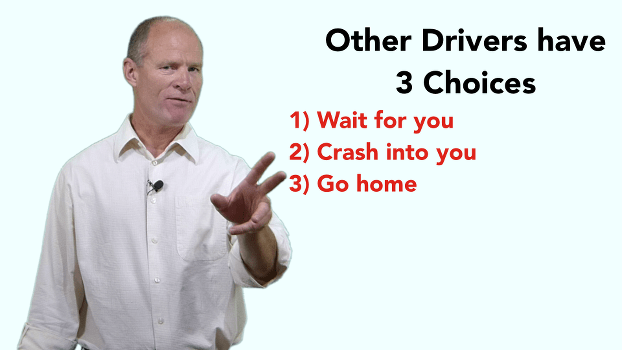 #5—Left Turns
#5—Left Turns
For novice drivers, left turns probably present the biggest challenge.
One of the things you want to do on a left-hand turn— many people, even driving instructors— will tell you to get right into the intersection.
If you're not comfortable and you're a new driver—you're a novice driver— don't drive into the intersection.
Because you're going to be stuck out there.
Put the front wheels your vehicle on the front crosswalk line.
That way you're committed to the turn, but you're not in the intersection.
If something goes wrong: you decide not to go, you're not paying attention, there's too much stuff going on and the light goes yellow to red, then you're not in the intersection.

Yes you're annoying the pedestrians because you're across the crosswalk, but you're not in the intersection - you're not stuck in the intersection.
The other thing with left-hand turns:
If you don't feel that gap is big enough coming the other way don't go, just simply don't go.
Yes other people may get annoyed and honk behind you, but like I say to students all the time:
"they got three choices:
1) they can wait for you;
2) they can crash into you;
3) or they can go home - whatever."
So you know - just take a breath, wait for the gap that you are comfortable with to make that left hand turn.
Finally on the left-hand turn for novice drivers, you may have to go on the yellow.
If you get stuck in the intersection, the light goes to yellow.
You've got to clear the intersection.
Now know that when you're in that intersection, you own the intersection.
So take your time and go.

Look in the direction where you're going to go.
As well, when you're going on the yellow, make sure that somebody's not coming through - is not charging at yellow light and pushing through it.
So make sure all the vehicles on the other side are coming to a stop before you proceed through the intersection.
So left-hand turns - take your time, take a deep breath.
Don't go unless you're comfortable and you may have to go on the yellow.
If you go on the yellow, make sure that cars are not coming through from the other side and are actually stopping.
#6—Following Distance
Following distance - following too close.
As I say to many a student, time and time again - if you're not near anything, it's less likely you're going to hit it.

Keep away from other vehicles - not only in your following distance when you're going up and down the road - 2 to 3 seconds in a car or light truck, an ambulance and whatnot.
Five seconds in bigger vehicles.
And for those of you towing big RV trailers, same thing - increase your following distance three to four seconds.
And I'll put a video up here for the video on following distance.
So you can watch that and determine how to judge your following distance.
As well, when you pull up to the traffic, don't pull up as close to the vehicle in front of you as you can.
Stop back so you can see the tires of the vehicle in front of you making clear contact with the pavement.
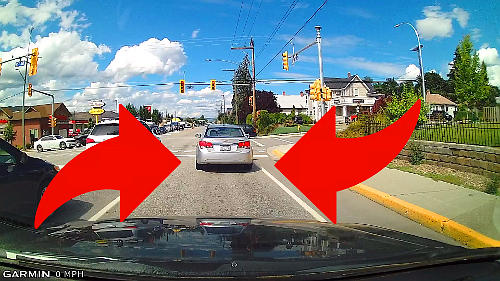
And again, there's a video up here about stopping in traffic, and I'll put that up for you.
There's lots of defensive reasons about staying back at least a vehicle length from the vehicle in front of you at traffic lights.
And the other thing is if everybody stayed back a vehicle length from the vehicle in front of them when they stopped at traffic lights the whole pack could move off much faster than what it does.
Because when you're right close, everybody's gotta wait for the person in front of them to go before they can go.
Whereas if you got some space between you—a buffer—everybody could move off at the same rate.
But you know - we all have our illusions of utopia and that's never going to happen.
But try and keep a bit of space there.
As i said, if you're not near anything, it's less likely you're going to hit something.
And in terms of following distance, we know that forty percent of traffic crashes happen in intersections.
If you see something that could potentially materialize into a hazard, obstacle, or conflict - get your foot over the brake.
Cover the brake and cut down your reaction time.
As well, leave space around your vehicle so in the event of an emergency that that does culminate into an emergency you can drive around it.
It's much faster to drive around something than it is to brake!
But if you cover the brake, it's going to cut down your reaction time and I'll put a video up here on covering the brake, if you don't know what covering the brake is.
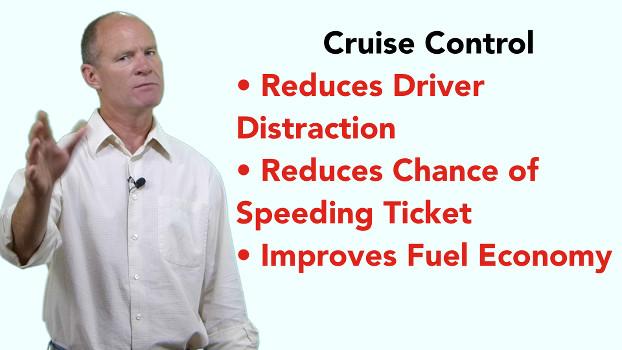 #7—Cruise Control
#7—Cruise Control
Cruise control - I am a huge advocate of cruise control.
I love cruise control, especially on the highway.
If you use cruise control, it will cut down on driver distraction because you're not watching the speed limit and monitoring the speed limit all the time on your vehicle.
So use cruise control - get it set.
And as well, if you find yourself running up on other cars all the time and have to turn your cruise off and whatnot, just set it to two three kilometers less than what the traffic flow is.
That way you'll never have to turn it off.
As well, it will reduce speeding tickets because you're not running up over the speed limit all the time.
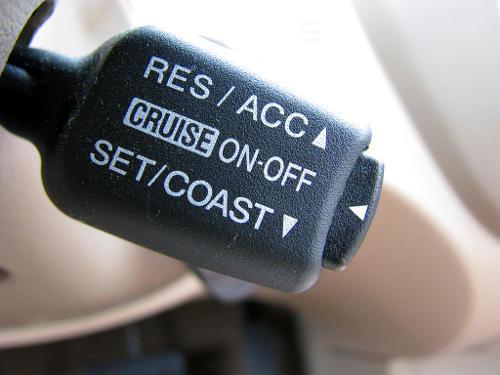
So the less chance of getting a speeding ticket with cruise control.
And finally, improved fuel economy because you get a nice steady speed with your vehicle.
So cruise control - use as much as possible.
#8—Shoulder Check
Shoulder check anytime you bring that vehicle laterally.
Shoulder check - shoulder check in the direction that you're moving the vehicle.
If you're shoulder checking to the left: 90° degrees to the left - just have a look.
It's your peripheral vision that checks it out here, if you're checking.
If you're moving to the right, shoulder check right.
Move your head 90° degrees.
That's all you have to do.
It will help you determine if somebody's in the blind spot.
And every vehicle has blind spots - so make sure you shoulder check.
If you're physically unable - you have a physical disability that prevents you from being able to shoulder check.
You can't move your head and neck then move from the hips.
If you can't move from the hips, go buy yourself convex mirrors and stick them on your mirrors.
That way you can determine if there are vehicles in your blind spots
Shoulder check or get convex mirrors so you can see in the blind spots of the vehicle.
#9—Distracted & Impaired Driving
Distracted driving - this is a big one.
And I really don't have the answers for distracted driving.

We all live in a world where we all have cell phones; we all live in a world of modern vehicles that are full of telematics.
These screens that show you back up cameras, and your stereo, and your radio and all kinds of GPS information.
And people do all kinds of things in their vehicles: they listen to their iPod, they have headphones in, they're shaving, they're putting on makeup, they're drinking, they're eating their talking on the phone, they're doing all kinds of things.
So I really - the only advice that I can give you about distracted driving—because studies show that this is an increasing problem and it's not getting any better/
And people are just becoming more and more pervasive in their use of cell phones and doing other things in their vehicle:
Don't do it in busy traffic; don't do it when you're around other vehicles; and if it really becomes all-consuming from the task of driving; pull over get off the road.
Stop the vehicle.
In any event, you should try and do that anyway.
Get yourself a hands-free device so that you can talk on your phone without having to look at your phone.
Figure out how to use the voice commands on your phones.
All this stuff is getting better.
Distracted driving!
Now in terms of distracted driving is also impaired driving.
And we all know about drinking and driving and drugs and driving - don't do it!
Now this may come as a bit of surprise to many of you, but the number one way that people are impaired when driving is through prescribed medication.
If you are unsure about the prescription that you are taking in terms of prescribed medication, talk to your pharmacist, talk to your doctor about physical effects that may have on you in terms of driving.
#10—Emotional Control
Emotional control - we all get frustrated, we all get anxious when our reality collides with our expectations.
Every one of us gets in her car thinking that 'happy doody'!
Everything's going to be great - just going to drive down the road and then somebody cuts us off; somebody speeds past us; were behind a senior citizen doing 30 in a 50.
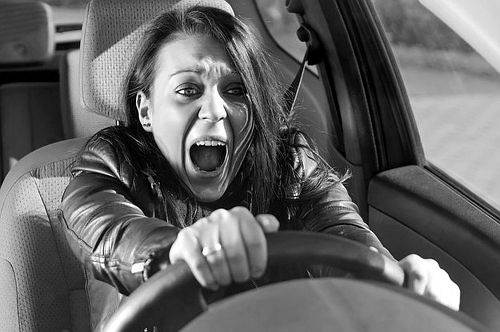
All that stuff drives crazy and sends us over the edge - even to the point of road rage.
Take a breath.
Know that there is going to be traffic.
If somebody cut you off, just smile, nod, take a breath and let them go down the road and have their crash somewhere else.
Because if you can do that, you're going to lower your blood pressure, you're going to lower your cholesterol and you're going to have a much happier drive.
And the other thing about it: you can get all torqued out of shape about people cutting you off, but the reality is that in nine times out of ten situations that person that cut you off.
They didn't even know they cut you off and went to work and had a blissful day, while you're spending the rest of the day steaming about something that's really not that important.
Have you ever noticed that’s when you drive the people that drive faster than you are idiots and people that drive slower than your boneheads.
It's one of the things that unites us as drivers— globally—in the world.
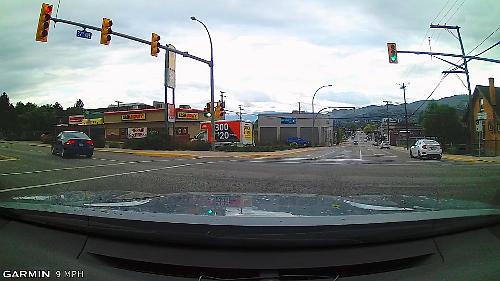
We get excited about driving.
Emotional control - figure out ways that when you drive you can just zone out.
One of the things that I do is I go to the library and get audio books and I listened to stories while I'm driving.
Especially if I got a 15 or 20 minute drive.
It just helps to get my mind busy, so I'm concentrating on something other than what other people are doing.
What you can expect - other people will speed; other people will drive too slow; other people to charge yellow lights; and those types of things.
So know that it's going to happen and have emotional control.
Conclusion
In conclusion, ways to keep you safe on the roadway after you get your license.
#1—Observaiton
Look, observe - look twice before you pull out and if you can't see creep out until you can see.
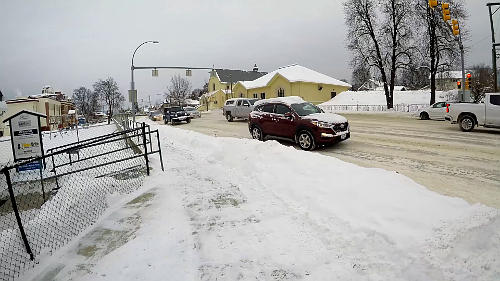
#2-Speed
Next thing, speed.
Stay with the traffic flow.
If you insist on doing the speed limit, stay over to the right-hand lane.
Stay out of the way.
Those signs slower traffic state right; stay right unless to pass.
Those are for you if you insist on doing the speed limit.
If you want to exceed the traffic flow, go to the racetrack.
#3—Communication
Signalling - make sure you communicate with other road users.
Signalling, hand gestures—appropriate hand gestures—eye contact.
All of these things will help you communicate with other road users.
And don't forget the most important way that we communicate with road users is the position of our vehicle on the roadway communicates our intentions.
#4: Vehicle Comfort.
Get a vehicle that you are comfortable driving.
If you're not comfortable driving it, don't drive it.
#5—OK, left-hand turns for novice drivers.
If you're not comfortable going, don't go.
Put the front tires on the front crosswalk line - that way you're committed to the intersection, but not in the intersection.
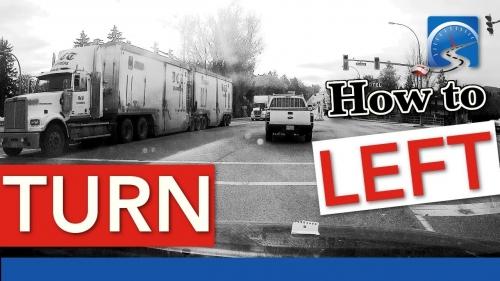
If you go on the yellow, make sure that the cars coming through from the other way are stopped or coming to a stop before you proceed through on the yellow.
#6—Following distance:
If you're not near anything, it's less likely that you're going to hit anything.
So stay away from other vehicles.
#7—Cruise Control
Maintain a good following distance when you come up and stop in traffic.
Make sure you're back at least one vehicle length.
All that's going to keep you safe.
#8—Shoulder checking - this is with observation.
Every time you move the vehicle laterally, make sure your shoulder check.
If you can't shoulder check because you have a physical impairment, get those little convex mirrors.
You can buy them at the hardware store.
They stick on your mirrors and they'll help you out to check the blind spots on your vehicle.
#9—Distracted driving.
Don't do it unless you absolutely have to.
If you do and you can get a spot that you can pull over - pull over and do that.
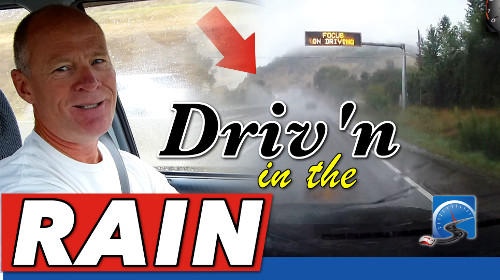
As well, leave yourself some more time so you can shave and do all those sorts of things at home.
#10 - emotional control.
Know that there's going to be traffic, know that somebody's going to cut you off - take a breath let them go and have their crash somewhere else.
Remaining calm is going to prevent road rage and going to prevent all of the things that are going to cause you to make bad decisions while you're driving.
Remember pick the best answer, not necessarily the right Have a safe driving career.
Remember: don't speed, and stay away from things.
And you can be right, or you can be 'dead right!'

